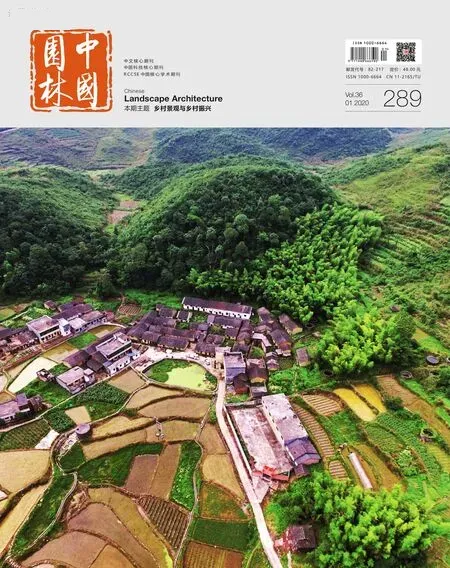刊首语
2020-01-18李雄
乡村是人类文明的发源地,其独特的景观记录了人类文明的演变过程。相较于城市,乡村的自然生态受人类干扰强度较低,其保存完好的自然生态系统成为生物多样性保护的重要基底。然而,在快速城镇化的背景下,乡村的生态、生活和生产空间不断受到冲击,自然原生的山川河流被污染,历史悠久的民居祠堂被破坏,维持生存的农业生产空间被不断蚕食。乡村地域广阔,直接影响着国土生态和人居环境的水平,为解决我国乡村面临的问题,十九大报告提出实施乡村振兴战略“产业兴旺、生态宜居、乡风文明、治理有效、生活富裕”的总方针,实施乡村振兴战略是建设美丽中国的关键举措,乡村是生态涵养的主体区,生态是乡村最大的发展优势。为此,政府印发《农村人居环境整治三年行动方案》《乡村绿化美化工程实施方案》等系列政策文件,为乡村生态保护研究和实践提供了重要指引。
风景园林学作为引领绿色发展的重要支撑学科,在服务于乡村生态环境建设和乡村振兴中应该发挥重要作用。我们应该认识到以下几点:从空间布局来看,乡村是国土空间规划中具有战略保障性和价值突出性的最重要组成部分;从构成要素来看,乡村是山水林田湖草和人居环境所有自然与人工资源要素的集合;从内涵本质来看,乡村是自然生态、聚落环境、绿色产业和地域文化等形成的多层次复合系统。乡村振兴、生态宜居是关键。因此,我们应该把乡村振兴放在美丽中国建设的核心位置。风景园林领域也应发挥其学科优势、贡献学科力量。为此,本期主题为“乡村景观与乡村振兴”,探索乡村景观研究体系,以期对中国乡村振兴和乡村景观的建设实践提供指导。
本期主题文章回答了乡村景观和乡村振兴的3个核心问题:建设什么样的乡村景观?如何建设乡村景观?谁来建设乡村景观?其中,《基于主导生态系统服务功能识别的北京市乡村景观提升策略研究》一文基于北京城市设施兴趣点(POI)和土地利用类型的解译数据,利用核密度分析及邻域分析的研究方法,识别北京各个乡村邻域缓冲区内的主导生态系统服务功能(Ecosystem Services,ES),探索应该建设什么样的乡村景观。另有4篇文章从不同尺度探讨了如何建设乡村景观。宏观层面上,《新时代乡村绿化美化的美学途径与科学导则》和《转译与输出——生态智慧在乡村建设中的应用》都是从宏观上提出乡村景观建设的途径和模式,前者认为应该传承和发展中国乡村传统人居美学思想,结合乡村的具体环境特点,构筑具有乡村特色的景观。后者在总结实践工作的基础上提出“向乡村学习-在地设计-触媒激活”的乡村建设工作过程和模式。中观层面上,《乡村聚落景观节约型设计策略探索》对乡村的聚落景观和建筑进行研究,提出以层级整合的空间结构、节制适度的营造方言和过程培育的绿植范式三方面实现乡村聚落景观的节约型设计。微观层面上,《场景·人物·精神——文化景观视角下香格里拉传统村落保护研究》对香格里拉地区传统村落小街子村的保护建设实践进行总结,建构了“文化-空间-时间”的村落文化景观多维分析框架。最后,《村民参与为主体的美丽乡村环境建设——以湖北红安县柏林寺村为例》则以专业领域的实践为例,强调了在共同缔造的理念下,村民应该是乡村景观建设的重要主体之一。
中国有近70万个行政村,在乡村振兴战略背景下,风景园林学科面临的机遇与挑战并存。乡村是风景园林参与国土空间规划的重要领域,我们应该积极探索生命共同体统筹治理的新途径,拓展中华优秀传统文化传承的新载体,构建中国美丽乡村建设的新篇章。
The countryside is the birthplace of human civilization,and its unique landscape has recorded the evolution of human civilization.Compared with cities,the natural ecology of countryside is less affected by human interference,and its well-preserved natural ecosystems have become an important basis for biodiversity protection.However,in the context of rapid urbanization,the ecology,living and production spaces of the countryside are constantly being impacted,the natural mountains and rivers are polluted,the historic ancestral halls are destroyed,and the agricultural production space that sustains them is constantly being eaten away.Rural areas account for more than 94% of China's total land area,which directly affects the level of land ecology and human settlements.In order to solve the problems faced by China's rural areas,the 19thCPC National Congress proposed the implementation of rural revitalization strategies:the general policy of "prosperous industry,ecological livability,rural civilization,effective governance,and affluent life",and implementing the strategy of revitalizing the countryside is a key measure for building a beautiful China.The countryside is the main area of ecological conservation,and ecology is the biggest development advantage of the countryside.To this end,the government issued a series of policy documents such as theThree-year Action Plan for Rural Human Settlement Environment Improvement and Implementation Plan for Rural Greening and Beautification Projects,which provided important guidelines for the study and practice of rural ecological protection.
As an important supporting discipline leading green development,landscape architecture should play an important role in serving rural ecological environment construction and rural revitalization.We should recognize the following points:from the perspective of the spatial layout,the countryside is the most important part of strategic land security and of outstanding value in the national spatial planning;from the perspective of the constituent elements,the countryside is the collection of all natural and artificial resource elements of forests,lakes,grasses,and human settlements;from the essence of connotation,the countryside is a multi-level composite system formed by natural ecology,settlement environment,green industry,regional culture,and so on.Ecological livability is key in revitalizing the countryside.Therefore,we should put rural rejuvenation at the core of the construction of beautiful China.The field of landscape architecture should also give play to its disciplinary advantage and contribute with its disciplinary strength.To this end,the theme of the first issue of 2020 is "Rural Landscape and Rural Revitalization",exploring the rural landscape research system,with a view to guiding the practice of rural revitalization and rural landscape construction in China.
This theme articles answer three core questions about rural landscape and rural revitalization:what kind of rural landscape to build,how to build the rural landscape,and who to build the rural landscape.Among them,Research on the Promotion Strategy of Rural Landscape in Beijing Based on the Identification of Dominant Ecosystem Serviceis based on the interpretation data of Beijing's POIs and land use types,using the research methods of nuclear density analysis and neighborhood analysis to identify the leading ecosystem services (ES) in the buffer zone of each rural neighborhood in Beijing,and explore what kind of rural landscape should be built.Another four articles explore the issue of how to build rural landscapes from different scales:on the macro level,bothStudy on the Aesthetic Approach and Scientific Guideline of Rural Greening and Beautification in the New EraandDecodeandEncode – Ecological Wisdom in Rural Developmentput forward the approach and model of rural landscape construction from a macro perspective.The former believes that the traditional rural human settlements aesthetic thoughts of China should be inherited and developed,and the specific environmental characteristics of the countryside should be combined to build a landscape with rural characteristics.The latter puts forward the rural construction work process and model of "learning from the countryside,local design and catalyst activation" based on the summary of practical work.On the meso level,Exploration on the Economical Design Strategy of Rural Settlementresearches rural settlement landscapes and architectures,and proposes to achieve rural settlements in three aspects:the spatial structure of hierarchical integration,the economical and moderate construction dialects,and the planting paradigms of process cultivation.On the micro level,
Scenes,People,and Spirit – Study on the Protection of Traditional Villages in Shangri-La from the Perspective of Cultural Landscapesummarizes the protection and construction practices of Xiaojiezi Village,a traditional village in Shangri-La,and builds the "culturespace-time" village cultural landscape multidimensional analysis framework.Finally,Villagers' Participation in the Construction of Beautiful Rural Environment – Taking Bolin Temple Village in Hong'an County,Hubei as the Exampletakes the practice in the professional field as the example and underscores the idea of co-creation,and villagers should be one of the important subjects of rural landscape construction.
There are nearly 700,000 administrative villages in China.In the context of the rural revitalization strategy,the opportunities and challenges of the landscape architecture discipline coexist.The countryside is an important area for the participation of landscape architecture in territorial space planning.We should actively explore new ways for the overall management of the community of life,expand the new carrier of Chinese excellent traditional culture,and build a new chapter in the construction of China's beautiful countryside.
